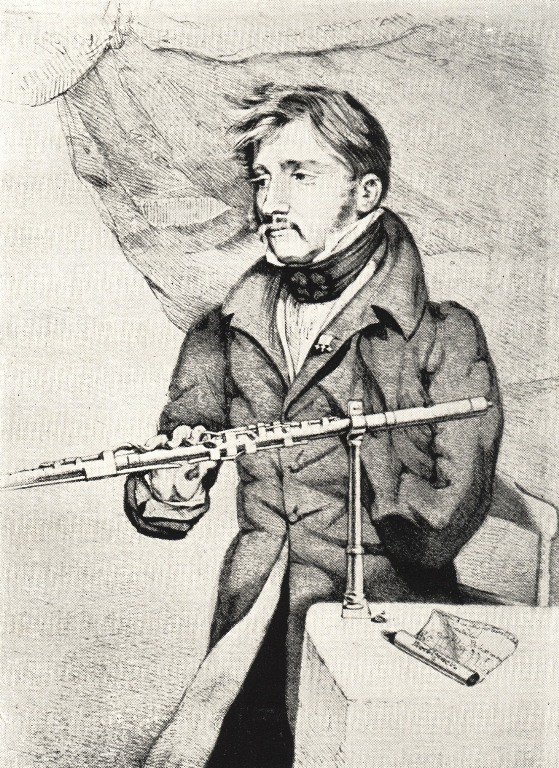Cornelius
Ward - The Flute Explained
§ 3. RECENT ATTEMPTS TO REMODEL THE FLUTE
- GORDON, BOEHM, ETC.
SOME excuse may be made for the flute being
at one period in the state we have described, by the fact that the laws of
the vibration of air in tubes were not well understood at the time the
Germans and French began to cultivate it as an instrument of music. And by
the time it had become, in a manner, established as such throughout
Europe, and not till then, the principles upon which it ought to have been
constructed were developed.
Even with the knowledge of these principles,
great difficulties existed in the way of their application, on account of
the number of apertures required, the limited number of the fingers, and
the prejudices of the professional' performers.
The first truly scientific remodelling of
the flute, with which we are acquainted, was made in 1803. It was a
great improvement upon the ordinary flute, inasmuch as the apertures were
placed more nearly in accordance with the acoustical principles of the
instrument. The manner of acting on the extra apertures was not, however,
so complete as could be desired, from the want of a little mechanical
skill in the party who devised it. We have one of these flutes at present
by us ; but, notwithstanding its superiority, it never came into use, from
the obstacles before alluded to, and because the time had not then arrived
when such an important improvement would be appreciated.
About the year 1831, we constructed a flute
under the direction of Captain Gordon, of Charles Xth's Swiss Guards, who
had been experimenting on this matter some time. In this flute, the
apertures were placed consistently with the proper length of tube required
for each fundamental note in the chromatic gamut; and the captain
contrived a method of acting upon the additional apertures beyond the
number of fingers. With this flute, the captain returned to Paris. Mr.
Boehm was at the same time trying to improve the flute, or to remodel it;
and it is said, with some reason, that he adopted a great part of the
captain's contrivance. Upon this matter much has been said and written,
and although some points were never clearly ascertained, we must give our
decided opinion that Gordon is entitled to most credit in the affair.
We have heard it remarked that the flute of
the extraordinary one-handed player, the talented Chevalier Rebsomen, was
the originator of the flute of Capt. Gordon. On this point also we are
able to speak decisively, as we were the maker of the chevalier's flute;
and can positively state that all the notes were made precisely as those
of the ordinary flute, excepting that all the apertures but three were
closed by keys. These three were the E, F#, and G ; which the chevalier
closed with the same three fingers that are applied to the same apertures
upon the ordinary flute. We further observed that he used the same
apertures for each note that are commonly used upon the flute, and that
the apertures were similarly situated. In a word, no part of Rebsomen's
flute could be considered an improvement; being merely the usual flute,
mechanically adapted to the owner's unfortunate curtailment of his fair
proportions.
[Ward does not
include an image of Rebsomen or his flute, so I've incorporated one from
The Story of the Flute, Fitzgibbon, London, 1928]

Captain Gordon ardently persevered in the
pursuit of his object, but did not obtain much favor from the professors;
he was considered to be of unsound mind, and that he was thus affected on
account on the defeat of his comrades and his own loss of fortune, in the
revolution of July. He was generally treated with consideration on that
account; but very little attention was paid to his flute mania, such being
the light in which his views respecting the flute were regarded. His
rival, Boehm, also failed in commanding any attention, on account of the
old objection, the requisite change in the fingering. After a considerable
lapse of time, however, (we believe about 1835,*) some of the professors
of Paris turned their attention to the proceedings of these gentlemen; we
believe that Camus was the first, but there are several candidates for the
honour. We consider it due to Captain Gordon to state, from our own
personal knowledge, that he was an ingenious, rational, and kind-hearted
gentleman; and we have reason to believe that he steadily persevered in
his efforts to improve the flute, with the view of amending his
circumstances. We have heard that he ultimately went mad, threw his flute
into the lake of Geneva, and soon after died, without deriving any benefit
from his invention.
The flute of Gordon is now in use by many of
the professors of Paris, and several ingenious men of that capital have
contributed to make it more perfect; the exertions of M. Doras in
particular, being entitled to great credit. There is, however, much
diversity of opinion, in Paris, as to the real and practical value of the
invention generally; and this, not without reason. For, although it is
acknowledged that the tones and intonation are much improved as compared
with the ordinary flute, yet the fingering is not simplified, nor is the
desired object obtained in other respects.
*
In 1835, Boehm played in public both in London and Paris; and previously
to this time there were several excel1ent players in Munich, particularly
Zaduck, a professor who performed in the Opera orchestra of that place.
On, to Acoustical and Mechanical
Requisites for a Perfect Flute
Back to the Cornelius Ward
Contents Page
Back to McGee Flutes
Contents Page |